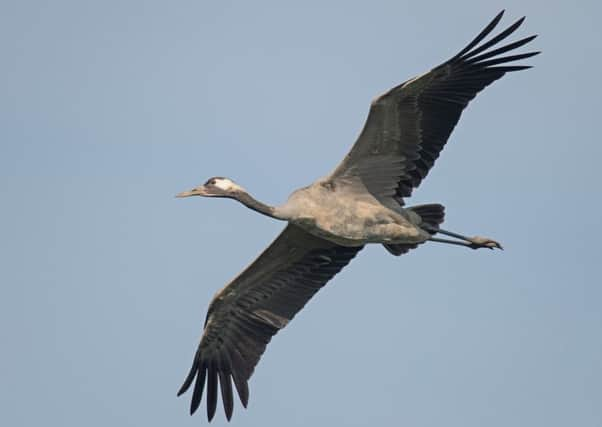Birdwatch: Common crane that is becoming more common around UK


Numbers, according to the Yorkshire Naturalists’ Union Bird report, are increasing in the county where common cranes now regularly summer at three extensive sites and there are annual breeding attempts with varying degrees of success.
However, as cranes are an extremely shy and wary bird, these locations are kept a close secret to avoid any disturbance.
Advertisement
Hide AdAdvertisement
Hide AdBut, from now on, as the cranes begin to disperse, they might be seen over a wider area sometimes feeding in stubble fields on spilled grain or invertebrates or in flight where their long outstretched necks and long legs extending beyond the tail distinguish them from grey herons.
On the ground common cranes can be seen to have mostly grey bodies with black wing plumes, black heads with a distinctive white facial streak and, in the adults, a red crown patch.
Yorkshire’s common cranes are thought to return to Norfolk for the winter to join the population there which is resident throughout the year.
The first pair bred there in 1982 when a single youngster was fledged and numbers have increased steadily with Hickling Broad a stronghold – the Norfolk Wildlife Trust’s Stubb Mill viewpoint is a good place to look for them from now on as they come in to roost along with large numbers of marsh harriers.
Advertisement
Hide AdAdvertisement
Hide AdThis year, for the second year running, two pairs have reared three young at the RSPB’s Lakenheath Fen reserve on the Norfolk/Suffolk border while two pairs on the Nene Washes have also reared three young.
Meanwhile, an ambitious scheme to reintroduce common cranes to the West Country is also being crowned with success.
The Great Crane Project has released almost 100 young cranes hatched from eggs brought from Germany at the Wildfowl and Wetlands Trust’s reserve at Slimbridge, Gloucestershire and this summer the first of these birds have successfully fledged young on the Somerset Levels and Moors – the first time for 400 years that cranes have bred in this area.
Birders from across the north were heading for Alkborough Flats on the Humber this week after a Western Swamphen was found there on Tuesday.
Advertisement
Hide AdAdvertisement
Hide AdIt is likely to be the one present at the RSPB’s Minsmere reserve in Suffolk last month and thought to be the first confirmed record of a wild rather than escaped one in Britain.
The Western Swamphen is a relative of coots and moorhens and has blue and purple plumage and a bright red bill and legs. It is found in Spain and Portugal and the south of France but has been seen further north than usual this year – another was present in Brittany.
A juvenile spotted crake is still at the North Cave Wetlands reserve, East Yorkshire.